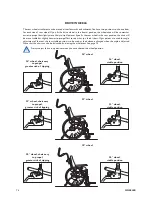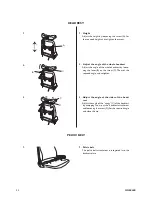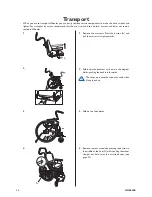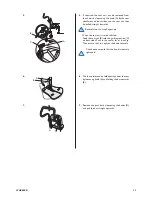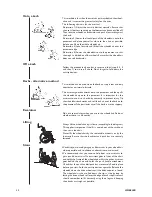
28
WHEELER
29
WHEELER
Safety instructions/propelling techniques
Wheeler must have been tested by the qualified person who has prescribed the wheelchair, after he or she
has made the adjustments that the user requests, taking the build and needs of the user into account. You
must also have received help in learning how best to use the wheelchair. Some simple tips are described below.
Start by practising carefully until the user is familiar with the wheelchair’s possibilities and limitations.
!
Move to/from the wheelchair
Propel the wheelchair as near as possible to the seat that you want
to move to. Apply the brake. Remove the armrests. Wheeler’s
foot plates withstand a load of 60 kg, but the user’s feet must be
inside of the castors.
Note any protruding components, and make sure that the user
does not injure himself or herself on them.
Stretching and bending
Propel the wheelchair as near as possible to the object. Do not
apply the brake (it is better to roll backwards than to tip over).
Propelling up a slope
In order not to lose control of the steering and to avoid tipping
backwards, you should always lean forwards whilst propelling up
a slope. Propel the wheelchair forwards using short, quick strokes
applied to the hand rims, in order to maintain speed and steering
control.
Generally, help is needed on steep slopes.
If you have to stop on a slope, it is particularly important to
ensure that you do not make any sudden or unexpected forward
movements when you start moving the wheelchair forwards again.
As the wheelchair is already leaning backwards, such a movement
may cause the wheelchair to tip backwards.
Propelling down a slope
We recommend that you obtain the help of one or more assis-
tants when going down steep and wet slopes.
First check the slope to see if there are any particular risks, such
as potholes, slippery sections, etc. Never use the user-operated
brake to slow down. When you apply the brake on a downward
slope, the wheels lock and the wheelchair can suddenly pull to
one side, tip sideways or stop immediately, which may cause you
to be thrown out of the chair. Always control the speed with
the hand rims. Remember that the hand rims may become hot
due to friction, and this may cause injury to your hands. Try to
propel down the slope in a straight line as much as possible.
Never change direction when propelling down a slope. Never
propel up or down a slope crosswise.


